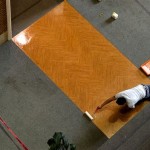Laminate Flooring Layout Planner: A Comprehensive Guide
Laminate flooring offers a durable, cost-effective, and aesthetically versatile alternative to hardwood and other flooring options. Successfully installing laminate flooring rests, in part, on meticulous planning, and the laminate flooring layout planner is an indispensable tool in this process. The layout planner helps to visualize the final appearance of the floor, minimize waste, and ensure a structurally sound and visually appealing installation.
This article provides a comprehensive exploration of the laminate flooring layout planner, detailing its significance, the key considerations involved in its application, and the methods employed to achieve optimal results. It aims to equip individuals with the knowledge to undertake a successful laminate flooring installation, whether for a small room or a large expanse.
Understanding the Importance of a Laminate Flooring Layout Planner
The significance of a laminate flooring layout planner extends beyond merely determining the quantity of materials required. A well-considered plan addresses several critical aspects of the installation process, contributing to both cost savings and enhanced aesthetics. Without a proper plan, installers risk generating excessive waste, encountering structural weaknesses, and creating visually unappealing patterns.
One of the primary reasons for using a layout planner is to minimize waste. Laminate flooring planks typically come in fixed lengths and widths. Without a plan, cuts can be haphazard, leading to significant offcuts that cannot be reused. By carefully planning the layout, the installer can strategically position planks to minimize the amount of material that needs to be cut, thereby reducing waste and saving money. This is particularly important for rooms with irregular shapes or features like doorways and corners.
The layout also directly impacts the structural integrity of the floor. Laminate flooring is designed to be a “floating floor,” meaning it is not directly attached to the subfloor. Instead, the planks interlock with each other, forming a continuous surface. The strength of this surface depends on the proper interlocking of the planks and the staggering of the end joints. A well-thought-out layout ensures that these joints are staggered correctly, preventing weaknesses and potential separation of the planks over time.
Furthermore, the aesthetic appeal of the floor is heavily influenced by the layout. The direction in which the planks are laid, the pattern of the end joints, and the placement of cut planks all contribute to the overall look and feel of the room. A layout planner allows the installer to experiment with different orientations and patterns to achieve the desired visual effect. For instance, running planks parallel to the longest wall can make a room appear larger, while a staggered pattern can add visual interest and help to conceal imperfections in the subfloor.
Key Considerations When Planning a Laminate Flooring Layout
Several critical factors must be taken into account when developing a laminate flooring layout. These include the room’s dimensions and shape, the subfloor condition, the direction of the light source, and the desired aesthetic effect. Ignoring these factors can lead to problems during installation and a less-than-satisfactory final result.
The dimensions and shape of the room are fundamental to the layout planning process. Accurate measurements are essential to determine the amount of flooring needed and to create a detailed plan. Irregularly shaped rooms, with alcoves or angled walls, require more careful planning to minimize waste and ensure a cohesive appearance. It is crucial to identify the longest wall in the room, as this often dictates the direction in which the planks are laid. Also, noting the locations of doorways, windows, and other architectural features is vital for planning cuts and transitions.
The condition of the subfloor is another critical consideration. Laminate flooring requires a level and stable subfloor to prevent issues such as warping, buckling, or squeaking. Any imperfections in the subfloor, such as bumps, dips, or cracks, must be addressed before installation begins. If the subfloor is uneven, a self-leveling compound may be necessary to create a smooth surface. In some cases, an underlayment may be required to provide additional cushioning and insulation, as well as to help correct minor imperfections. The underlayment also provides a moisture barrier which is critical in areas prone to dampness.
The direction of the primary light source should also influence the layout. Typically, it is recommended to lay the planks parallel to the direction of the light source. This minimizes the visibility of seams and creates a more uniform appearance. However, personal preference and other design considerations may override this recommendation. For example, in long, narrow rooms, running the planks perpendicular to the longest wall can make the room appear wider.
Finally, the desired aesthetic effect is a crucial factor in layout planning. Different laying patterns can create different visual effects. A straight lay, where the planks are laid in parallel rows, is the most common and simplest option. A staggered lay, where the end joints are staggered from row to row, is more visually interesting and helps to distribute stress more evenly. Herringbone and other more complex patterns can also be used, but they require more careful planning and cutting.
Methods for Creating a Laminate Flooring Layout Plan
Several methods exist for creating a laminate flooring layout plan, ranging from manual techniques to sophisticated software applications. The choice of method depends on the complexity of the project, the available resources, and the installer’s level of experience.
The simplest method is to manually sketch out the layout on a piece of paper. This involves drawing a scaled representation of the room and then sketching out the placement of the planks. This method is suitable for simple, rectangular rooms, but it becomes more challenging for irregularly shaped rooms with multiple obstacles. Manual planning requires careful measurement and attention to detail to ensure accuracy. It also allows for quick experimentation with different layouts and patterns.
Spreadsheet software, such as Microsoft Excel or Google Sheets, can also be used to create a layout plan. This involves creating a grid that represents the room and then entering the dimensions of the planks into the cells of the grid. The spreadsheet can then be used to calculate the number of planks needed and to visualize the layout. This method is more precise than manual sketching, but it still requires a significant amount of manual data entry. Additionally, spreadsheet software often lacks the visual tools needed to easily experiment with different patterns.
Specialized laminate flooring layout software offers the most comprehensive and accurate approach to planning. These applications typically allow users to import a digital image of the room's floor plan or to create one using built-in drawing tools. The user can then specify the dimensions of the laminate planks and experiment with different layouts using drag-and-drop functionality. The software automatically calculates the amount of material needed and generates a cut list, minimizing waste and ensuring accuracy. Some software packages also offer features such as 3D visualization, allowing the user to see what the finished floor will look like before installation begins.
Regardless of the method chosen, it is always a good idea to dry-lay the first few rows of planks before permanently installing them. This allows the installer to verify the accuracy of the layout plan and to make any necessary adjustments. Dry-laying also provides an opportunity to identify any potential problems, such as unevenness in the subfloor or mismatches in the plank patterns.
Preparing the subfloor is a critical step before laying any flooring. Remove any existing flooring, carpet, or baseboards. Clean the subfloor thoroughly to remove dirt, dust, and debris. Inspect the subfloor for any damage or imperfections, and repair them as needed. If using an underlayment, install it according to the manufacturer's instructions. Be sure the underlayment covers the entire subfloor area and is properly secured. The subfloor must be level and firm to prevent future problems with the laminate flooring.
Selecting the proper tools is also vital for a successful installation. Essential tools include a measuring tape, a pencil, a circular saw or jigsaw, a tapping block, a pull bar, spacers, and a hammer. A moisture meter can be used to check the moisture content of the subfloor, ensuring that it is within acceptable limits before installation begins. Safety goggles and ear protection are recommended to protect against dust and noise.
Before installing the first plank, it is important to leave an expansion gap around the perimeter of the room. Laminate flooring expands and contracts with changes in temperature and humidity. The expansion gap allows the flooring to move freely without putting pressure on the walls or other fixed objects. Spacers are used to maintain the correct expansion gap while the flooring is being installed.
During the installation process, carefully follow the manufacturer's instructions for installing the laminate planks. Most laminate flooring uses a click-lock system, where the planks are angled and snapped together. Use a tapping block and pull bar to gently tap the planks into place, ensuring a tight and seamless connection. Avoid using excessive force, as this can damage the planks. Regularly check the alignment of the planks to ensure that they are straight and even.
When cutting planks to fit around obstacles such as doorways, pipes, or corners, use a jigsaw or circular saw with a fine-tooth blade. Measure carefully and mark the cutting lines accurately. Make clean, precise cuts to avoid splintering or chipping the edges of the planks. Use a coping saw or similar tool to make intricate cuts or curves.
Once the flooring is completely installed, remove the spacers and install baseboards or quarter-round molding to cover the expansion gap. The baseboards or molding should be nailed or glued to the wall, not to the flooring. This allows the flooring to move freely without being restricted. Clean the floor thoroughly to remove any dust or debris from the installation process.
Maintaining the laminate flooring is essential for preserving its appearance and longevity. Regularly sweep or vacuum the floor to remove dirt and dust. Use a damp mop with a mild detergent to clean the floor as needed. Avoid using excessive water, as this can damage the laminate. Protect the floor from scratches and dents by using furniture pads under heavy objects. Address spills immediately to prevent staining or water damage. With proper care and maintenance, laminate flooring can provide years of beauty and durability.

How To Design A Floor Using Free

How To Design A Floor Using Free

Calculator Laminate Flooring The Calculation Of Number Planks

How To Design A Floor Using Free

How To Design A Floor Using Free

Draft 2 For The Flooring Free Design 3d Diy Floor Plans By Planner 5d

How To Design A Floor Using Free

Vinyl Flooring Calculator Measure Square Corp

Laminate Flooring Calculator Measure Square Corp

How To Layout A Floor My Busy Retired Life
Related Posts








